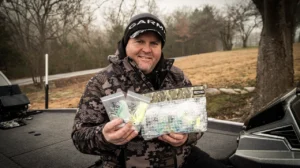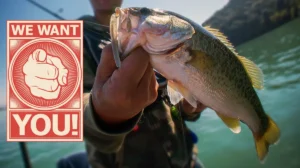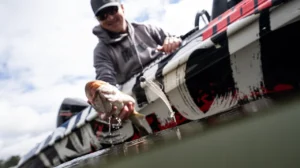Let’s face it — the bluegills off the dock of your family’s cottage have gotten smaller and smaller as summer goes on. The water has warmed up, weeds fill the shallows, and not a big bluegill in sight. Small bluegills gather at the tip of the dock, but the big ones are almost nonexistent. Where could they have possibly gone? They were around earlier in the year and can’t be that far, right?
Like bass, bull bluegills get into a post-spawn funk around midsummer. Then, they proceed to one place. And that’s deep water you likely can’t reach with a cast from your dock. But why are they going there? What drives them to stay deep in the summertime? Aren’t they supposed to be shallow? Here’s how to target and consistently catch big bluegills in the heat of summer.
Why Do Bluegills Go Deep?

Like bass, walleyes, pike and other panfish, bluegills are no stranger to heading into the abyss for the majority of the summer months. The water temperature gets too hot to stay in the shallows, so bluegills migrate away from shorelines in search of oxygen-rich water. Panfish hanging in shallows go together like perch and fish fries, right? Not always. Bluegills don’t sit by the boat ramps and docks all summer long, at least not the big ones.
Along with water temperature, food has a lot to do with them moving deeper. Bluegills are what biologists call “peckers,” meaning they use their small mouths to peck insects from different objects. As the weeds grow deeper throughout the summer months, bluegills will move deeper to keep up with the new weed growth and available food source in the weeds.
How to Find Bluegills In Deep Water

Most species of fish don’t aimlessly swim around the middle of the lake for no reason. Bluegills are no exception. They will associate with some type of structure. And that structure you can often locate with your electronics, including dropoffs, main lake points, and deepwater weed edges. Structure creates habitat for the fish to forage and hide in. Some species, like bluegill, relate to certain structures throughout the year. Here are a few different structures that big bluegills love to hang around during the duration of the summer months.
Deep Weedlines
Of course, most anglers look for weeds when bluegill fishing. Aquatic vegetation holds many beneficial attributes for the species. For big bluegills, it provides shade, plenty of oxygen, and a great source of food in the form of small invertebrates. For a bull ‘gill, this is paradise and they would never have to leave. Bass are often buried in the heart of the vegetation, but that’s not the case for bluegills. Bigger bluegills tend to use the edges of the weeds as a feeding point, as well as a travel highway to find more food. Deep weedlines can be the best and easiest way to find big bluegills in the summertime.
Offshore Humps
You would think this is where larger predatory fish hangout, but in reality you can find some of the biggest bluegills in the lake living along offshore humps. What does an offshore hump have to offer? Simple, lots of food. A bluegill’s diet consists of mostly invertebrates and larger zoo plankton — there are lots of both prey items offshore.
For an offshore hump to be productive, there has to be some sort of bottom substrate. Rock outcroppings, shell beds and sunken trees — all of this will hold big bluegills in the summer. There has to be something for the prey to hide in. Not every hump is going to have them, so do some scanning around with your 2D or sidescan sonar to find which ones are holding structure and fish. Forward facing sonar can also come into play while scanning these offshore humps to spot the clouds of big bluegills and pick apart the larger fish from the school.
Steep Banks
Wherever a bank leads into extremely deep water, this spot is easy access to cooler water for all species of fish. Like deep weedlines, this is an area where big bluegills never have to leave. Why? Because it has everything that a big bluegill wants. Plenty of forage living within the substrate, easy access to cooler water when the temps rise, and cover from possible deeper docks and fallen trees. It’s paradise for big bluegills to thrive all summer long.
Steep shorelines can be fairly easy to find from just looking around. Look for banks that have a steep gradient from land going into the water. Most likely the bank will continue that steep decline into the lake and eventually bottom out deep. You can also see steep banks on topographic maps of the lake when contour lines lay extremely close to one another.
Top Baits and Tactics For Deep Summertime Bluegills

When it comes to catching big bull ‘gills in the summertime, there are definitely some tactics that shine brighter than others. Here are a few of my favorites for bringing big bull bluegills up from the depths.
Dropshot Rigs
A dropshot is my main tactic throughout the year for big bluegills, but especially in deeper water during the summer. While most bluegills are suspended out deep, a dropshot will present a bait hovering above the bottom to attract those suspended fish. I love to fish a dropshot with a long leader between the hook and the sinker, usually around 18 to 24 inches to keep the bait off the bottom where the bluegills are staging.
You can never go wrong with a size four or six Gamakatsu Octopus Hook in red. I love a colored hook for bluegill fishing because it draws in more bites as bluegills are extremely curious. For weights, depending on how deep you’re fishing, you may need sizes ranging from 3/16 to ⅜ ounces just to stay on the bottom. For baits, there are many different artificials that I love to use, like a Reins Rockvibe Shaker or a Keitech Swing Impact. But for a more consistent bite, live bait is usually the way to go. Small leeches, half a nightcrawler or a redworm work perfectly.
Split-Shot Rigs
Often called the “poor man’s Carolina rig,” the split-shot rig is a perfect way to keep the bait close to the bottom, while allowing the bait to be presented in a natural manner hovering above the bottom. This technique is perfect if you see bluegill hugging tighter to the bottom closer to the structure.
The depth will determine how many split shots are used along your line. Usually, I keep a variety pack of Water Gremlin split shots in my boat at all times so I can change them out on the fly. My rig usually consists of three number-seven-size split shots that are 36 inches above a number six Eagle Claw Aberdeen Hook in gold color. The key with the Aberdeen hook is the longer shank will allow for easy de-hooking of the bluegill. With this rig they might swallow the bait deeper, so a long-shank hook will be more beneficial to not harm the fish. Artificial baits work great on this rig, like a Trout Magnet Nymph or Hellgramite or a Berkley Powerbait Mayfly.
Deep Slip Floats
Often the most common way to catch bluegills, utilizing a slip float can be a blast and a great way to effectively present a bait in windy conditions. Using a Thill Slip Float, a bead and a bobber stop, you can make any small jig or soft plastic dance in the water. In windy conditions, the float moving through the chop on the water makes the bait have incredible action. This is a perfect presentation around deep weedlines and steeper shorelines where bluegills are often suspended higher in the water column.
After setting the bobber stop to the desired depth, choosing the right bluegill bait can make or break getting more bites. I often choose a smaller marabou jig as opposed to plastics because under a float, a plastic bait doesn’t have nearly as much action as marabou or any other craft fur. Hair has much better flow through the water. My go to is a VMC Tungsten BullFly tipped with either a wax worm or piece of a night crawler. The live bait is just for added scent to draw in more curious bluegills to bite.
Final Thoughts
When it comes to deep water bluegills in the heat of the summer, it can be a real challenge to find the big ones. These tactics have been proven to not only catch big ones, but consistently land big bluegills in your boat summer after summer. Go deep, I say. Try these tips the next time you’re on the water and you’ll be filling your freezer with delicious bull ‘gills regularly.










